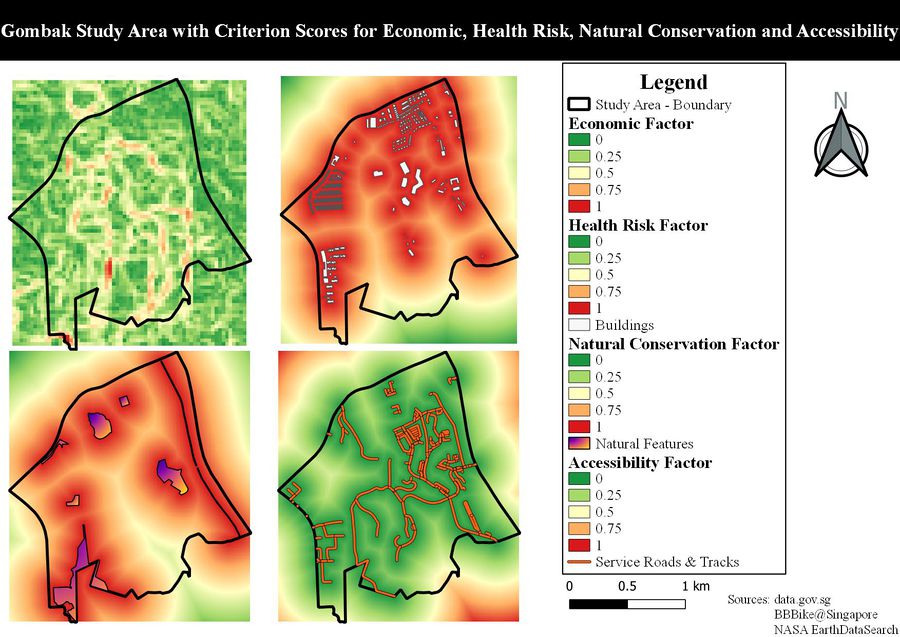Difference between revisions of "JeromeQuah Ex2 CriterionScores"
| Line 28: | Line 28: | ||
From this, the following steps were carried out in the digitization of each of the views for this map: | From this, the following steps were carried out in the digitization of each of the views for this map: | ||
| − | + | 1. '''Standardization:''' ''Normalization'' of all four Proximity Layers of the respective factors via the '''Minimum-Maximum Formula''' using the Raster Calculator<br> | |
| − | [[File:Minimum-Maximum Formula JeromeQuah.jpg|thumb|center|'''Criteria Standardization Technique: The Minimum-Maximum Formula''']] | + | [[File:Minimum-Maximum Formula JeromeQuah.jpg|thumb|center|'''Criteria Standardization Technique: ''The Minimum-Maximum Formula''''']] |
| + | * Example of Formula in Raster Calculator:<br> | ||
| + | ''(Proximity Map of Feature − Minimum Value of Proximity Map of Feature) ÷ (Maximum Value of Proximity Map of Feature − Minimum Value of Proximity Map of Feature)'' | ||
| + | |||
| + | 2. '''Uniformity:''' ''Inversion of Raster Values'' of the Buildings and Natural Features Layer using the Raster Calculator<br> | ||
| + | * Example of Formula in Raster Calculator:<br> | ||
| + | ''(1 − Normalized Proximity Map of Roads)'' | ||
|} | |} | ||
| − | + | 3. '''Symbology''' ''Band Rendering'' of each of the Normalized Proximity Layers with a ''Linear'' Interpolation and ''Continuous'' Mode, providing the ''Criterion Score Scale of 0 to 1'' for all four layers.<br> | |
| + | 0 Represents the ''FAVOURABLE'' pixel value | ||
| + | 1 Represents the ''UNFAVOURABLE'' pixel value | ||
Revision as of 03:19, 9 November 2019
| OVERVIEW | PROXIMITY | CRITERION SCORES | AHP | SUITABILITY |
|---|
| In order to come up with a standardized Criterion Score, we would have to ensure that the scale used across all four maps would have to be uniformed as well as the raster values of all four maps denoting the same value meaning at both ends of the scale. To further understand this better, the following was considered: 1. Necessity to Standardise a Scale to Use Across All Four Factors
2. Necessity to Invert Raster Pixel Value of Certain Map Views
From this, the following steps were carried out in the digitization of each of the views for this map: 1. Standardization: Normalization of all four Proximity Layers of the respective factors via the Minimum-Maximum Formula using the Raster Calculator
(Proximity Map of Feature − Minimum Value of Proximity Map of Feature) ÷ (Maximum Value of Proximity Map of Feature − Minimum Value of Proximity Map of Feature)
(1 − Normalized Proximity Map of Roads) |
3. Symbology Band Rendering of each of the Normalized Proximity Layers with a Linear Interpolation and Continuous Mode, providing the Criterion Score Scale of 0 to 1 for all four layers.
0 Represents the FAVOURABLE pixel value
1 Represents the UNFAVOURABLE pixel value
| ECONOMIC FACTOR (SLOPE) |
|---|
| From the Slope Layer (Bottom Right), similar to the Digital Elevation - Contour Lines Map View, the degree of the land terrain of Gombak tends to increase when progressing from the North region to the South region of Gombak, in which Gombak Hill is within that proximity. From this, it is in our best interests that we do not consider the Southern areas of Gombak with high slope degrees for the suitable site for building the CQDC in terms of Economic. |
| HEALTH RISK FACTOR (BUILDINGS) |
|---|
| From the Slope Layer (Bottom Right), similar to the Digital Elevation - Contour Lines Map View, the degree of the land terrain of Gombak tends to increase when progressing from the North region to the South region of Gombak, in which Gombak Hill is within that proximity. From this, it is in our best interests that we do not consider the Southern areas of Gombak with high slope degrees for the suitable site for building the CQDC in terms of Economic. |
| NATURAL CONSERVATION FACTOR (NATURAL FEATURES) |
|---|
| From the Slope Layer (Bottom Right), similar to the Digital Elevation - Contour Lines Map View, the degree of the land terrain of Gombak tends to increase when progressing from the North region to the South region of Gombak, in which Gombak Hill is within that proximity. From this, it is in our best interests that we do not consider the Southern areas of Gombak with high slope degrees for the suitable site for building the CQDC in terms of Economic. |
| ACCESSIBILITY FACTOR (ROADS) |
|---|
| From the Slope Layer (Bottom Right), similar to the Digital Elevation - Contour Lines Map View, the degree of the land terrain of Gombak tends to increase when progressing from the North region to the South region of Gombak, in which Gombak Hill is within that proximity. From this, it is in our best interests that we do not consider the Southern areas of Gombak with high slope degrees for the suitable site for building the CQDC in terms of Economic. |

